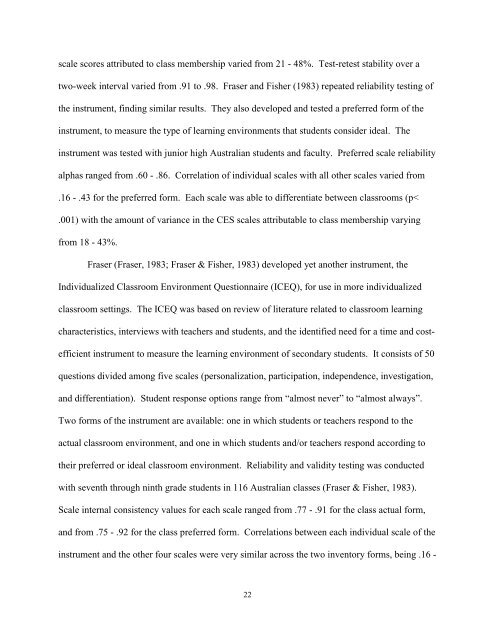STUDENT EVALUATION OF CLINICAL EDUCATION ENVIRONMENT
STUDENT EVALUATION OF CLINICAL EDUCATION ENVIRONMENT
STUDENT EVALUATION OF CLINICAL EDUCATION ENVIRONMENT
Create successful ePaper yourself
Turn your PDF publications into a flip-book with our unique Google optimized e-Paper software.
scale scores attributed to class membership varied from 21 - 48%. Test-retest stability over a<br />
two-week interval varied from .91 to .98. Fraser and Fisher (1983) repeated reliability testing of<br />
the instrument, finding similar results. They also developed and tested a preferred form of the<br />
instrument, to measure the type of learning environments that students consider ideal. The<br />
instrument was tested with junior high Australian students and faculty. Preferred scale reliability<br />
alphas ranged from .60 - .86. Correlation of individual scales with all other scales varied from<br />
.16 - .43 for the preferred form. Each scale was able to differentiate between classrooms (p<<br />
.001) with the amount of variance in the CES scales attributable to class membership varying<br />
from 18 - 43%.<br />
Fraser (Fraser, 1983; Fraser & Fisher, 1983) developed yet another instrument, the<br />
Individualized Classroom Environment Questionnaire (ICEQ), for use in more individualized<br />
classroom settings. The ICEQ was based on review of literature related to classroom learning<br />
characteristics, interviews with teachers and students, and the identified need for a time and cost-<br />
efficient instrument to measure the learning environment of secondary students. It consists of 50<br />
questions divided among five scales (personalization, participation, independence, investigation,<br />
and differentiation). Student response options range from “almost never” to “almost always”.<br />
Two forms of the instrument are available: one in which students or teachers respond to the<br />
actual classroom environment, and one in which students and/or teachers respond according to<br />
their preferred or ideal classroom environment. Reliability and validity testing was conducted<br />
with seventh through ninth grade students in 116 Australian classes (Fraser & Fisher, 1983).<br />
Scale internal consistency values for each scale ranged from .77 - .91 for the class actual form,<br />
and from .75 - .92 for the class preferred form. Correlations between each individual scale of the<br />
instrument and the other four scales were very similar across the two inventory forms, being .16 -<br />
22












